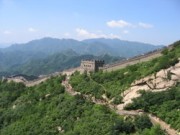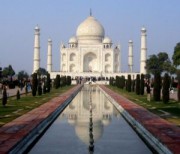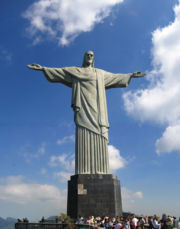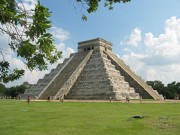Selected new 7 wonders of the world
It was a small discovery for me, but nevertheless, elections of the new seven wonders of the world were held. Why this was done and why the old ones are outdated, I propose to discuss in the comments. Here I would like to talk about the results.








 Only the pyramids of Giza were able to confirm their rank. They were built during the reign of the 4th dynasty of the pharaohs about 4,500 years ago. about 1600 talents were spent on the construction; if you translate it into modern money, you will get about $ 25–30 million. The height of the pyramids is 145 meters (an analogue of a fifty-storey skyscraper). Originally, the pyramids were conceived not as a center of tourism and pilgrimage, but as a tomb for Pharaoh Cheops.
Only the pyramids of Giza were able to confirm their rank. They were built during the reign of the 4th dynasty of the pharaohs about 4,500 years ago. about 1600 talents were spent on the construction; if you translate it into modern money, you will get about $ 25–30 million. The height of the pyramids is 145 meters (an analogue of a fifty-storey skyscraper). Originally, the pyramids were conceived not as a center of tourism and pilgrimage, but as a tomb for Pharaoh Cheops.
 The Roman Coliseum was recognized as the second wonder of the world. The construction of the amphitheater was begun by Emperor Vespasian after his victories in Judean land. And the Colosseum was presented to the public in the year 80 AD by the emperor Titus on one hundred-day celebrations in honor of his inauguration. The Colosseum made it possible to accommodate 50,000 people at a time and later became a trendsetter in the construction of sports stadiums.
The Roman Coliseum was recognized as the second wonder of the world. The construction of the amphitheater was begun by Emperor Vespasian after his victories in Judean land. And the Colosseum was presented to the public in the year 80 AD by the emperor Titus on one hundred-day celebrations in honor of his inauguration. The Colosseum made it possible to accommodate 50,000 people at a time and later became a trendsetter in the construction of sports stadiums.
')
 The Great Wall of China also entered new seven wonders. Contrary to common misconception, from space is not visible to the naked eye, although in satellite photographs, it is, of course, visible . The length of the wall is 6,350 km. It was built in the period from VII to IV century BC. Emperor Qin Shih Huangdi completed the project, combining all the existing sites. The wall was built to protect against the raids of the Turkic tribes, the Mongols and the Huns.
The Great Wall of China also entered new seven wonders. Contrary to common misconception, from space is not visible to the naked eye, although in satellite photographs, it is, of course, visible . The length of the wall is 6,350 km. It was built in the period from VII to IV century BC. Emperor Qin Shih Huangdi completed the project, combining all the existing sites. The wall was built to protect against the raids of the Turkic tribes, the Mongols and the Huns.

The Taj Mahal , a mausoleum located in Agra, was also listed. It was built by order of the emperor Shah Jahan in memory of the wife of Mumtaz Mahal, who died during childbirth. The Taj Mahal is a vivid example of Mughal architecture, combining Indian, Persian and Islamic architecture.
 Petra is the capital of Idumea . The city is located on the territory of modern Jordan, at an altitude of more than 900 meters above sea level and 660 meters above the surrounding countryside, the Arava Valley. In the valley you can pass through the gorges, located in the north and south, while from the east and west, the cliffs fall steeply, forming natural walls up to 60 meters in height. The most famous of the entire complex is Ad-Gyar - the unfinished portal leading to the city (which should be well known to everyone who watched Indana Jones :)
Petra is the capital of Idumea . The city is located on the territory of modern Jordan, at an altitude of more than 900 meters above sea level and 660 meters above the surrounding countryside, the Arava Valley. In the valley you can pass through the gorges, located in the north and south, while from the east and west, the cliffs fall steeply, forming natural walls up to 60 meters in height. The most famous of the entire complex is Ad-Gyar - the unfinished portal leading to the city (which should be well known to everyone who watched Indana Jones :)
 Statue of Christ the Savior in Rio de Janeiro, Brazil. The height is about 38 meters, and the weight is more than 1000 tons. The statue was conceived in the 1920s and began to be built in 1926. According to the ideas of the authors Haytor da Silva Costa and Paul Landowski, Christ had to look around Rio de Janeiro from the hill (which, in general, was possible). The elements of the statue were raised to the top of the hill with the help of a cog railway, where they were subsequently assembled. The opening of the statue was held in 1931
Statue of Christ the Savior in Rio de Janeiro, Brazil. The height is about 38 meters, and the weight is more than 1000 tons. The statue was conceived in the 1920s and began to be built in 1926. According to the ideas of the authors Haytor da Silva Costa and Paul Landowski, Christ had to look around Rio de Janeiro from the hill (which, in general, was possible). The elements of the statue were raised to the top of the hill with the help of a cog railway, where they were subsequently assembled. The opening of the statue was held in 1931
 Machu Picchu in Peru. Built in the 15th century by the efforts of the Inca Empire, the city is sometimes called the “lost city of the Incas”. The complex, consisting of giant walls, palaces and temples, is located at an altitude of 2,450 meters above sea level in the Andes. It still remains a mystery how huge stones were brought to the top. After 400 years of neglect, the city was again discovered by an American researcher from Yale University, Professor Hiram Bingham in 1911. The uniqueness of the city lies in the fact that 100 years after its construction, the conquistadors destroyed the Inca Empire, but could not reach the city.
Machu Picchu in Peru. Built in the 15th century by the efforts of the Inca Empire, the city is sometimes called the “lost city of the Incas”. The complex, consisting of giant walls, palaces and temples, is located at an altitude of 2,450 meters above sea level in the Andes. It still remains a mystery how huge stones were brought to the top. After 400 years of neglect, the city was again discovered by an American researcher from Yale University, Professor Hiram Bingham in 1911. The uniqueness of the city lies in the fact that 100 years after its construction, the conquistadors destroyed the Inca Empire, but could not reach the city.
 And finally, the pyramids of Chichen Itza - the Maya political and cultural center in the north of the Yucatan Peninsula, Mexico. The famous step pyramids were part of the large city of Maya Yucatan, the construction of which took into account the solar calendar. The complex includes many temples, on the terraces of which bloody sacrifices so loved by filmmakers were made. The Chichen Itza pyramids are a good example of the architectural mastery of famous astronomers and warriors.
And finally, the pyramids of Chichen Itza - the Maya political and cultural center in the north of the Yucatan Peninsula, Mexico. The famous step pyramids were part of the large city of Maya Yucatan, the construction of which took into account the solar calendar. The complex includes many temples, on the terraces of which bloody sacrifices so loved by filmmakers were made. The Chichen Itza pyramids are a good example of the architectural mastery of famous astronomers and warriors.
PS And now the main question. Selected sights are certainly an interesting and revered heritage of ancient and not very civilizations. However, it is not clear why it was necessary to hold elections of the “wonders of the world”, why not call them something else? Your thoughts?








 Only the pyramids of Giza were able to confirm their rank. They were built during the reign of the 4th dynasty of the pharaohs about 4,500 years ago. about 1600 talents were spent on the construction; if you translate it into modern money, you will get about $ 25–30 million. The height of the pyramids is 145 meters (an analogue of a fifty-storey skyscraper). Originally, the pyramids were conceived not as a center of tourism and pilgrimage, but as a tomb for Pharaoh Cheops.
Only the pyramids of Giza were able to confirm their rank. They were built during the reign of the 4th dynasty of the pharaohs about 4,500 years ago. about 1600 talents were spent on the construction; if you translate it into modern money, you will get about $ 25–30 million. The height of the pyramids is 145 meters (an analogue of a fifty-storey skyscraper). Originally, the pyramids were conceived not as a center of tourism and pilgrimage, but as a tomb for Pharaoh Cheops. The Roman Coliseum was recognized as the second wonder of the world. The construction of the amphitheater was begun by Emperor Vespasian after his victories in Judean land. And the Colosseum was presented to the public in the year 80 AD by the emperor Titus on one hundred-day celebrations in honor of his inauguration. The Colosseum made it possible to accommodate 50,000 people at a time and later became a trendsetter in the construction of sports stadiums.
The Roman Coliseum was recognized as the second wonder of the world. The construction of the amphitheater was begun by Emperor Vespasian after his victories in Judean land. And the Colosseum was presented to the public in the year 80 AD by the emperor Titus on one hundred-day celebrations in honor of his inauguration. The Colosseum made it possible to accommodate 50,000 people at a time and later became a trendsetter in the construction of sports stadiums.')
 The Great Wall of China also entered new seven wonders. Contrary to common misconception, from space is not visible to the naked eye, although in satellite photographs, it is, of course, visible . The length of the wall is 6,350 km. It was built in the period from VII to IV century BC. Emperor Qin Shih Huangdi completed the project, combining all the existing sites. The wall was built to protect against the raids of the Turkic tribes, the Mongols and the Huns.
The Great Wall of China also entered new seven wonders. Contrary to common misconception, from space is not visible to the naked eye, although in satellite photographs, it is, of course, visible . The length of the wall is 6,350 km. It was built in the period from VII to IV century BC. Emperor Qin Shih Huangdi completed the project, combining all the existing sites. The wall was built to protect against the raids of the Turkic tribes, the Mongols and the Huns.
The Taj Mahal , a mausoleum located in Agra, was also listed. It was built by order of the emperor Shah Jahan in memory of the wife of Mumtaz Mahal, who died during childbirth. The Taj Mahal is a vivid example of Mughal architecture, combining Indian, Persian and Islamic architecture.
 Petra is the capital of Idumea . The city is located on the territory of modern Jordan, at an altitude of more than 900 meters above sea level and 660 meters above the surrounding countryside, the Arava Valley. In the valley you can pass through the gorges, located in the north and south, while from the east and west, the cliffs fall steeply, forming natural walls up to 60 meters in height. The most famous of the entire complex is Ad-Gyar - the unfinished portal leading to the city (which should be well known to everyone who watched Indana Jones :)
Petra is the capital of Idumea . The city is located on the territory of modern Jordan, at an altitude of more than 900 meters above sea level and 660 meters above the surrounding countryside, the Arava Valley. In the valley you can pass through the gorges, located in the north and south, while from the east and west, the cliffs fall steeply, forming natural walls up to 60 meters in height. The most famous of the entire complex is Ad-Gyar - the unfinished portal leading to the city (which should be well known to everyone who watched Indana Jones :) Statue of Christ the Savior in Rio de Janeiro, Brazil. The height is about 38 meters, and the weight is more than 1000 tons. The statue was conceived in the 1920s and began to be built in 1926. According to the ideas of the authors Haytor da Silva Costa and Paul Landowski, Christ had to look around Rio de Janeiro from the hill (which, in general, was possible). The elements of the statue were raised to the top of the hill with the help of a cog railway, where they were subsequently assembled. The opening of the statue was held in 1931
Statue of Christ the Savior in Rio de Janeiro, Brazil. The height is about 38 meters, and the weight is more than 1000 tons. The statue was conceived in the 1920s and began to be built in 1926. According to the ideas of the authors Haytor da Silva Costa and Paul Landowski, Christ had to look around Rio de Janeiro from the hill (which, in general, was possible). The elements of the statue were raised to the top of the hill with the help of a cog railway, where they were subsequently assembled. The opening of the statue was held in 1931 Machu Picchu in Peru. Built in the 15th century by the efforts of the Inca Empire, the city is sometimes called the “lost city of the Incas”. The complex, consisting of giant walls, palaces and temples, is located at an altitude of 2,450 meters above sea level in the Andes. It still remains a mystery how huge stones were brought to the top. After 400 years of neglect, the city was again discovered by an American researcher from Yale University, Professor Hiram Bingham in 1911. The uniqueness of the city lies in the fact that 100 years after its construction, the conquistadors destroyed the Inca Empire, but could not reach the city.
Machu Picchu in Peru. Built in the 15th century by the efforts of the Inca Empire, the city is sometimes called the “lost city of the Incas”. The complex, consisting of giant walls, palaces and temples, is located at an altitude of 2,450 meters above sea level in the Andes. It still remains a mystery how huge stones were brought to the top. After 400 years of neglect, the city was again discovered by an American researcher from Yale University, Professor Hiram Bingham in 1911. The uniqueness of the city lies in the fact that 100 years after its construction, the conquistadors destroyed the Inca Empire, but could not reach the city. And finally, the pyramids of Chichen Itza - the Maya political and cultural center in the north of the Yucatan Peninsula, Mexico. The famous step pyramids were part of the large city of Maya Yucatan, the construction of which took into account the solar calendar. The complex includes many temples, on the terraces of which bloody sacrifices so loved by filmmakers were made. The Chichen Itza pyramids are a good example of the architectural mastery of famous astronomers and warriors.
And finally, the pyramids of Chichen Itza - the Maya political and cultural center in the north of the Yucatan Peninsula, Mexico. The famous step pyramids were part of the large city of Maya Yucatan, the construction of which took into account the solar calendar. The complex includes many temples, on the terraces of which bloody sacrifices so loved by filmmakers were made. The Chichen Itza pyramids are a good example of the architectural mastery of famous astronomers and warriors.PS And now the main question. Selected sights are certainly an interesting and revered heritage of ancient and not very civilizations. However, it is not clear why it was necessary to hold elections of the “wonders of the world”, why not call them something else? Your thoughts?
Source: https://habr.com/ru/post/31156/
All Articles